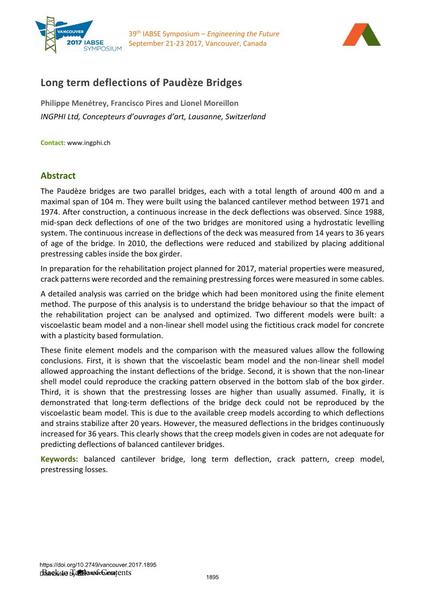Long term deflections of Paudèze Bridges

|
|
|||||||||||
Bibliografische Angaben
| Autor(en): |
Francisco Menétrey
(INGPHI Ltd, Concepteurs d’ouvrages d’art, Lausanne, Switzerland)
Lionel Moreillon (INGPHI Ltd, Concepteurs d’ouvrages d’art, Lausanne, Switzerland) |
||||
|---|---|---|---|---|---|
| Medium: | Tagungsbeitrag | ||||
| Sprache(n): | Englisch | ||||
| Tagung: | IABSE Symposium: Engineering the Future, Vancouver, Canada, 21-23 September 2017 | ||||
| Veröffentlicht in: | IABSE Symposium Vancouver 2017 | ||||
|
|||||
| Seite(n): | 1895-1902 | ||||
| Anzahl der Seiten (im PDF): | 8 | ||||
| Jahr: | 2017 | ||||
| DOI: | 10.2749/vancouver.2017.1895 | ||||
| Abstrakt: |
The Paudèze bridges are two parallel bridges, each with a total length of around 400 m and a maximal span of 104 m. They were built using the balanced cantilever method between 1971 and 1974. After construction, a continuous increase in the deck deflections was observed. Since 1988, mid-span deck deflections of one of the two bridges are monitored using a hydrostatic levelling system. The continuous increase in deflections of the deck was measured from 14 years to 36 years of age of the bridge. In 2010, the deflections were reduced and stabilized by placing additional prestressing cables inside the box girder. In preparation for the rehabilitation project planned for 2017, material properties were measured, crack patterns were recorded and the remaining prestressing forces were measured in some cables. A detailed analysis was carried on the bridge which had been monitored using the finite element method. The purpose of this analysis is to understand the bridge behaviour so that the impact of the rehabilitation project can be analysed and optimized. Two different models were built: a viscoelastic beam model and a non-linear shell model using the fictitious crack model for concrete with a plasticity based formulation. These finite element models and the comparison with the measured values allow the following conclusions. First, it is shown that the viscoelastic beam model and the non-linear shell model allowed approaching the instant deflections of the bridge. Second, it is shown that the non-linear shell model could reproduce the cracking pattern observed in the bottom slab of the box girder. Third, it is shown that the prestressing losses are higher than usually assumed. Finally, it is demonstrated that long-term deflections of the bridge deck could not be reproduced by the viscoelastic beam model. This is due to the available creep models according to which deflections and strains stabilize after 20 years. However, the measured deflections in the bridges continuously increased for 36 years. This clearly shows that the creep models given in codes are not adequate for predicting deflections of balanced cantilever bridges. |
||||
| Stichwörter: |
Rissbild
|
||||
